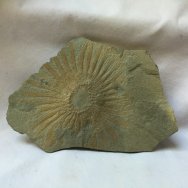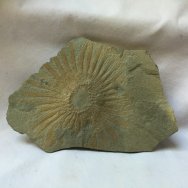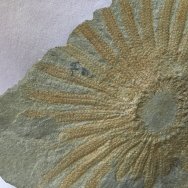Lepidasterella
montanensis
Class Stelleroidea,
Order Spinulosida, Family Heliathasteridae
Geological
Time: Mississippian (~320 m.y.a.)
Size (25.4
mm = 1 inch): Fossil is 135 mm by 125 mm across;
Matrix: 195 mm by 125 mm
Fossil Site:
Heath Shale Formation, Bear Gulch Limestone, Fergus County, Montana
Fossil Code:
BGF700
Price: Sold
|  Description:
The Bear Gulch Limestone is a deposit of some 70 square km in
extent and 30 m in depth that has been a source of one of the
most diverse assemblages of fossil fish with some 110 species
having been described over the past 30 years. Most were new to
science, and provided a unique view of the marine environment
of Mississippian times. Fine preservation of both fish and invertebrates
is a hallmark of these deposits, presumably due to an anoxic
depositional environment. This specimen is a fine example of
a many-armed starfish called Lepidasterella. At the time of its
discovery some 25 years ago it was the only many-armed starfish
known from the time interval ranging from the Upper Devonian
to the Lower Jurassic. The closest living relatives are the Sun
Stars of the Family Solasteridae which are known as active and
voracious predators. Sea Stars are one of the less commonly seen
Paleozoic echinoderms, and thus poorly documented from the western
United States, making this one quite unique. Since Asterozoans
typically begin to disarticulate soon after death, this one must
have been buried quickly to be in such a fine state of preservation.
This one is the positive, and presented here without restoration,
just a simple color wash to bring out detail. The many tube feet
can clearly be seen an each individual arm. I have had some
half dozen specimens ever, and this one is doubtlessly the best
of the lot. Description:
The Bear Gulch Limestone is a deposit of some 70 square km in
extent and 30 m in depth that has been a source of one of the
most diverse assemblages of fossil fish with some 110 species
having been described over the past 30 years. Most were new to
science, and provided a unique view of the marine environment
of Mississippian times. Fine preservation of both fish and invertebrates
is a hallmark of these deposits, presumably due to an anoxic
depositional environment. This specimen is a fine example of
a many-armed starfish called Lepidasterella. At the time of its
discovery some 25 years ago it was the only many-armed starfish
known from the time interval ranging from the Upper Devonian
to the Lower Jurassic. The closest living relatives are the Sun
Stars of the Family Solasteridae which are known as active and
voracious predators. Sea Stars are one of the less commonly seen
Paleozoic echinoderms, and thus poorly documented from the western
United States, making this one quite unique. Since Asterozoans
typically begin to disarticulate soon after death, this one must
have been buried quickly to be in such a fine state of preservation.
This one is the positive, and presented here without restoration,
just a simple color wash to bring out detail. The many tube feet
can clearly be seen an each individual arm. I have had some
half dozen specimens ever, and this one is doubtlessly the best
of the lot.
|
|





